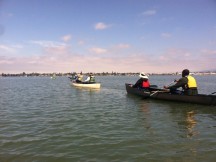
The estuary provides the backdrop for daily life in the greater Bay Area. It shapes and influences everything from our commute – including bridges, ferries and tunnels – to our very weather. It also supports a vast array of non-human inhabitants: migratory birds that can outnumber the human population every winter, as well as marine mammals, fish, and invertebrates. This month celebrates the 20th anniversary of a partnership of agencies that developed the Comprehensive Conservation and Management Plan (CCMP) for San Francisco Bay, dedicated to monitoring and improving the health of our estuary. The partnership is hosting the 11th biennial State of the Estuary Conference (SOE) on October 29 and 30 in Oakland.
Research has helped shed light on the bay’s complex ecosystems and threats posed by pollution, development and diminished habitats. Our estuary is radically altered from its condition 150 years ago: over 85% of historical wetlands lost to development, mercury and other contaminants remain as relics in the sediment, and the swell of human inhabitants brings other impacts such as increased atmospheric carbon and imported invasive species. At this month’s SOE conference, scientists, researchers and land managers currently working on projects in the Bay will make over 50 presentations. At the previous gathering in 2011, a State of the Bay report was released which indicated the mixed health of the bay. A different report, The Bay Pulse, will be released this year on the second day of the conference and will highlight two major new trends.

I spoke with Jay Davis from the San Francisco Estuary Institute and one of the co-organizers of the SOE. “One of the trends the report examines,” he said, “is the rise of ‘contaminants of concern’ in the bay including flame retardants, stain repellents and pesticides. These contaminants enter the bay from a variety of sources that are difficult to control. Treated sewage releases, urban stormwater runoff, agricultural runoff and the atmosphere are all pathways for chemicals to enter the bay.”
Jay added, “The levels of these chemicals need to be monitored as they can affect the reproduction and development of apex predators like harbor seals, cormorants and sharks as the chemicals accumulate up the food chain.”

The second trend is an increase in the amount of algae growth in our formerly resilient estuary. Jay explained, “Historically, higher turbidity decreased algae blooms in the estuary. In 1999, the bay reached a tipping point, becoming less turbid.” Jim Cloern of the US Geological Survey hypothesizes that changes in the clam population in the southern part of the bay, along with changes in fish abundance eating the clams linked with climate oscillations (including El Nino), played into making the bay clearer and ripe for increased, unwanted algae growth.